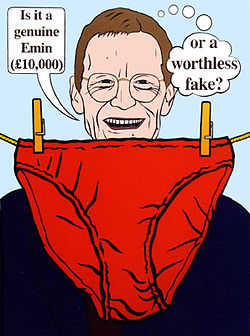Open Access/2011/January/Visual Arts
Open Access
Issue 1 - January 2011
|
Visual Arts on Wikipedia
- By Johnbod
Jimbo Wales has more than once singled out the visual arts as one of the weakest areas of Wikipedia's coverage, and despite much improvement that probably remains true. In the early days vast numbers of articles were added unaltered from the out of copyright Encyclopedia Britannica 1911 edition, and too many of these remain little changed, even for artists as important as Lucas Cranach and Tintoretto. Even at the time the quality of the 1911 art entries was criticized; and they and their language are now often hopelessly outdated. The “Yorck Archive,” a commercial CD-ROM of thousands of scans from books that were out of copyright in Germany, was added to Commons and is usually the source of the many washed-out images of older paintings in articles. There are a number of active editors battling to improve mattters, who tend to divide into those working on contemporary and recent art, and those covering earlier periods.
The Visual arts WikiProject is more active than many, though by no means all editors active in the area are seen there, and the Architecture, Archaeology and Photography wikiprojects cover those areas. Ceoil has marshalled a team that has been responsible for most recent art Featured Articles; altogether there are a little over 40 of over 10,000 articles tagged for the project (not all articles have tags). Now that someone has apparently removed Lady Gaga’s project tag, Leonardo da Vinci has resumed his traditional “place” at the head of the project’s list of most popular pages, with an average 15,411 views in October 2010, a good way ahead of the runner-up, Picasso (10,431), and with nearly twice as many as Michelangelo (8,108). Lower down the rankings, in the 170s, we reach Eugène Delacroix, Max Ernst and Jacques-Louis David, all at just around 1,000 views a day.
The project does not go in for quality or importance ratings much, but it is often the case that the largest subjects have the weakest articles, for understandable reasons. In the case of British art, Art of the United Kingdom (recently improved) was all too typical, with the inevitable duplication of (slightly better) articles on English art, Scottish art, and Welsh art. But there is much excellent coverage of the Young British Artists, Stuckists and the London contemporary art scene, by User:Tyrenius and others, though copyright restrictions are a huge constraint here.
User:PKM has contributed many articles on early British portraiture (from California) such as Portraiture of Elizabeth I of England, and Category:William Hogarth paintings and prints. Hogarth and Joseph Wright of Derby are well covered by User:Yomangani, though most British 18th century art is not. Many works by William Blake have good articles, and User:Paul Barlow and others cover the Pre-Raphaelites. More generally, classical sculpture and Ancient Greek vase painting are among many other pockets of quality. Of other Wikipedias that I can get a feel for, the German Wikipedia is often better than than the English on individual subjects, but this is surprisingly rare in the French and Italian ones, while many Dutch editors seem to prefer to write for English WP. Many articles are clearly translated from the English Wikipedia on all other language versions; I find my articles regularly get shortened versions in Thai.
Most content issues in the field relate strictly to contemporary art, where much material on obscure artists and works, and sometimes not so obscure ones, has COI (conflict of interest) issues, sometimes with copyright violation concerns as well, and where there are some furious editing rows. Edit Wikipedia and meet the art community! Almost all visual arts AfDs (decisions on Articles for Deletion) are on recent topics. Other predictable flashpoints include the possible gayness of Leonardo, and the possible Croatianess etc. of various people. But most areas of the visual arts are pretty drama-free.
Generally painting is far better covered than sculpture, and coverage of the applied or “decorative arts” is pretty dire; that the Corel-Bridgeman decision applies only to two-dimensional works doesn't help here. African art is as poorly covered as everything else to do with Africa, and there is little quality content on Indian art, or ethnological art from most of the world. The situation in all these areas has been somewhat improved this year by the British Museum collaboration, which began with User:Witty lama spending June as the first “resident Wikipedian” in any museum, and has continued to generate content surprisingly well, much of it tied to the Radio 4/British Museum series “A History of the World in 100 Objects”. As well as a “Backstage Pass” day and a prize contest, a special one-day “Hoxne Challenge” in the museum, where curators helped a group of Wikipedians to edit, led to Hoxne Hoard being promoted to FA 33 days later (time-lapse video). A conference was held at the British Museum in November to develop understanding between the cultural sector and Wikipedia. Another initiative was the “Britain loves Wikipedia” photography event in February, which added hundreds of photos to Commons, especially from the Victoria & Albert Museum, whose staff added wonderful full captions.
Wikipedia visual arts coverage had its 15 minutes of fame, when (to quote the Titian article):
On February 11, 2009, an argument about Titian's age at his death arose between British Prime Minister Gordon Brown, and Leader of the Opposition David Cameron at Prime Minister's Questions, where Cameron was attempting to ridicule Brown's general factual accuracy. This debate spilt over onto Titian's entry on Wikipedia, when an editor from Conservative Party HQ altered Titian's dates to substantiate David Cameron's claim and then directed the BBC to the article for them to use as verification. Cameron later apologized and said the staff member had been "disciplined".
Well, at least everyone agreed he was dead, so there was no BLP issue (insider joke)! At the beginning of the day, the main text correctly explained that nobody knew Titian's date of birth, even to within a year or two, but (with a certain inevitability) the infobox knew better, a good example of why most visual arts editors dislike infoboxes, the other reason being that, like templates, they use up space needed for pictures.
Comments on this feature
- "like templates, they use up space " <wry grin> Of course many templates take no space at all, including the one before this comment. Rich Farmbrough 01:39, 13 January 2011 (UTC)




